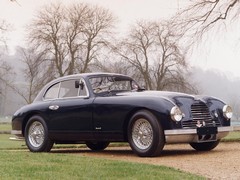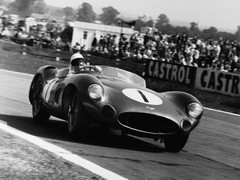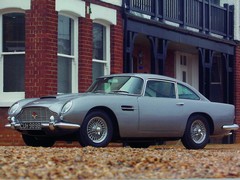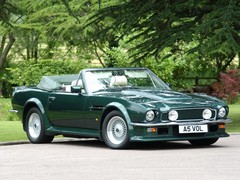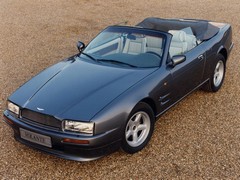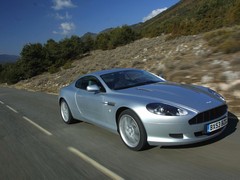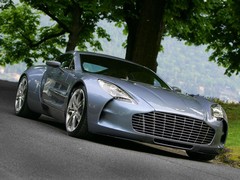RE: Happy 100th Birthday, Aston Martin
Tuesday 15th January 2013

It’s 100 years to the day since Aston Martin first went into business as Bamford & Martin Ltd. That’s a pretty epic milestone, whichever way you square it, and one which you’d have been forgiven for thinking the company might not reach, given the way it’s dangled over the proverbial precipice numerous times in its life. But, happily, Aston Martin is still with us today – which is as good an excuse as any for a nostalgic look back through the company’s back catalogue, at some of the cars that made it what it is today. Happy 100th, Aston Martin.
The 1922 1.5-litre was built to compete in the French Grand Prix of the same year, making it the first major competition car that Aston Martin built. As such, it paved the way for all of the company’s later successes, including Le Mans, a race that the company first took part in in 1928. The 1.5-litre used a four-cylinder, 1487cc engine that could take it right the way up to a heady 95mph, making it really very fast at the time.
After a series of financial troubles through the ‘30s and ‘40s, David Brown Limited bought the company in 1947, as well as the Lagonda car company, uniting the two for the first time. The first new model under David Brown’s stewardship bore the DB initials, to signify a break from the previous Aston Martin (now without the hyphen) models. The DB2 was a major leap forward over the 2-Litre Sports it replaced, with a 2.6-litre DOHC straight-six engine, and it set the trend for Aston Martin’s mainstay: the closed GT coupe. The DB2 was also the first Aston of which a high-performance ‘Vantage’ version was available.
Evolved from the DB3S, the DBR1 used a 2 .5-litre all-alloy straight six, which was later replaced by a 250hp three-litre version. In the latter form, it was the first Aston Martin to take an outright win at Le Mans, which it did in 1959. That wasn’t its only success, though; a series of four DBR1s took a total of six World Sports Car Championship races, setting five new lap records in the process, and culminating in overall championship victory.
For many, the most iconic car that Aston Martin ever produced entered production almost exactly fifty years ago, and a year later, the most famous one of all – BMT216A – made its screen debut as James Bond’s wheels in ‘Goldfinger’. Cubby Broccoli’s pitch-perfect choice of vehicle for Connery’s Bond brought Aston Martin to the world’s attention, and gave the company an image no money could buy. Its all-aluminium, four-litre straight six boasted 282hp, and could propel the DB5 to 145mph. A new five-speed manual transmission from ZF was standard fitment.
The first Aston to be powered by a V8 was based on the six-cylinder DBS, and made its debut in 1972. It set a trend for brutish V8-powered Astons that continues today, and in Vantage form it was one of the fastest and most desirable supercars of its day. Despite being well-received, it was not enough to save the company from the financial issues that continued to plague it, and three years after its launch, Aston Martin entered receivership.
Yet another period of turmoil for Aston Martin through the late ’70s and early ’80s meant the V8’s replacement was well overdue. And when it arrived, in the form of the Virage, it was derided by some for using Audi, VW and Ford parts in some very obvious places. Still, it was a quantum leap forward over the old V8, and it later spawned the unhinged twin-supercharged V8 Vantage Le Mans, which kicked out 612hp and 600lbft, could do 0-62mph in 3.9sec, and had a claimed top speed of 200mph.
The first car to emerge under Ford’s ownership was wholly different to the Virage that came before it. Gone was the square, bluff styling, replaced by slinky fastback body styled by Ian Callum that stunned the world. Under the skin, things were less impressive; the new car borrowed heavily from Ford and Jaguar’s parts bins, but despite this the DB7 was still a hugely desirable car. The supercharged 340hp 3.2-litre Jaguar straight-six was later joined by the 6.0-litre, 48-valve, 426hp V12 in the Vantage version, giving the DB7 the truly blistering performance it had always cried out for.
Although the DB7 did an incredible job of turning around Aston Martin’s image, by the turn of the millennium it was ageing, so Aston Martin replaced it in 2004 with the DB9. It took styling cues from the DB7 and later Vanquish, and moulded them into a lithe body that was again styled by Callum. The V12 engine, now standard, produced 477hp, and the DB9 was the first Aston to be built on the aluminium VH platform which is still in use today.
The resurrection of the V8 Vantage name was significant for Aston Martin, as was the car that bore it: this new ‘baby’ Aston marked the company’s first foray into the smaller V8-powered supercar market, rather than the large GT market that was its usual stomping ground. Powered by a 4.3-litre V8 with 380hp, it made Aston ownership more accessible while still providing the raffish charm that Aston had made its own.
One of the most exclusive cars Aston has ever produced, the One-77 was available only to 77 lucky owners - hence its name. Powered by a 7.3-litre V12 which produced 750hp, it was capable of 220mph, and had a 0-62mph time around the 3.5-second mark. At its heart sat a full carbon monocoque, which was then clothed in an aluminium skin, keeping weight down to a remarkable 1,500kg.
Happy 100th Birthday, Aston Martin
The firm that supplied Bond celebrates its centenary today, so we take a look through its back catalogue

1922 Aston-Martin 1.5-litre
The 1922 1.5-litre was built to compete in the French Grand Prix of the same year, making it the first major competition car that Aston Martin built. As such, it paved the way for all of the company’s later successes, including Le Mans, a race that the company first took part in in 1928. The 1.5-litre used a four-cylinder, 1487cc engine that could take it right the way up to a heady 95mph, making it really very fast at the time.
After a series of financial troubles through the ‘30s and ‘40s, David Brown Limited bought the company in 1947, as well as the Lagonda car company, uniting the two for the first time. The first new model under David Brown’s stewardship bore the DB initials, to signify a break from the previous Aston Martin (now without the hyphen) models. The DB2 was a major leap forward over the 2-Litre Sports it replaced, with a 2.6-litre DOHC straight-six engine, and it set the trend for Aston Martin’s mainstay: the closed GT coupe. The DB2 was also the first Aston of which a high-performance ‘Vantage’ version was available.
1956 DBR1
Evolved from the DB3S, the DBR1 used a 2 .5-litre all-alloy straight six, which was later replaced by a 250hp three-litre version. In the latter form, it was the first Aston Martin to take an outright win at Le Mans, which it did in 1959. That wasn’t its only success, though; a series of four DBR1s took a total of six World Sports Car Championship races, setting five new lap records in the process, and culminating in overall championship victory.
For many, the most iconic car that Aston Martin ever produced entered production almost exactly fifty years ago, and a year later, the most famous one of all – BMT216A – made its screen debut as James Bond’s wheels in ‘Goldfinger’. Cubby Broccoli’s pitch-perfect choice of vehicle for Connery’s Bond brought Aston Martin to the world’s attention, and gave the company an image no money could buy. Its all-aluminium, four-litre straight six boasted 282hp, and could propel the DB5 to 145mph. A new five-speed manual transmission from ZF was standard fitment.
The first Aston to be powered by a V8 was based on the six-cylinder DBS, and made its debut in 1972. It set a trend for brutish V8-powered Astons that continues today, and in Vantage form it was one of the fastest and most desirable supercars of its day. Despite being well-received, it was not enough to save the company from the financial issues that continued to plague it, and three years after its launch, Aston Martin entered receivership.
Yet another period of turmoil for Aston Martin through the late ’70s and early ’80s meant the V8’s replacement was well overdue. And when it arrived, in the form of the Virage, it was derided by some for using Audi, VW and Ford parts in some very obvious places. Still, it was a quantum leap forward over the old V8, and it later spawned the unhinged twin-supercharged V8 Vantage Le Mans, which kicked out 612hp and 600lbft, could do 0-62mph in 3.9sec, and had a claimed top speed of 200mph.
1993 DB7
The first car to emerge under Ford’s ownership was wholly different to the Virage that came before it. Gone was the square, bluff styling, replaced by slinky fastback body styled by Ian Callum that stunned the world. Under the skin, things were less impressive; the new car borrowed heavily from Ford and Jaguar’s parts bins, but despite this the DB7 was still a hugely desirable car. The supercharged 340hp 3.2-litre Jaguar straight-six was later joined by the 6.0-litre, 48-valve, 426hp V12 in the Vantage version, giving the DB7 the truly blistering performance it had always cried out for.
2004 DB9
Although the DB7 did an incredible job of turning around Aston Martin’s image, by the turn of the millennium it was ageing, so Aston Martin replaced it in 2004 with the DB9. It took styling cues from the DB7 and later Vanquish, and moulded them into a lithe body that was again styled by Callum. The V12 engine, now standard, produced 477hp, and the DB9 was the first Aston to be built on the aluminium VH platform which is still in use today.
The resurrection of the V8 Vantage name was significant for Aston Martin, as was the car that bore it: this new ‘baby’ Aston marked the company’s first foray into the smaller V8-powered supercar market, rather than the large GT market that was its usual stomping ground. Powered by a 4.3-litre V8 with 380hp, it made Aston ownership more accessible while still providing the raffish charm that Aston had made its own.
One of the most exclusive cars Aston has ever produced, the One-77 was available only to 77 lucky owners - hence its name. Powered by a 7.3-litre V12 which produced 750hp, it was capable of 220mph, and had a 0-62mph time around the 3.5-second mark. At its heart sat a full carbon monocoque, which was then clothed in an aluminium skin, keeping weight down to a remarkable 1,500kg.
Discussion
Gassing Station | General Gassing | Top of Page | What's New | My Stuff


